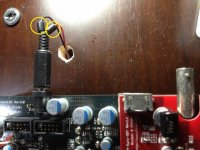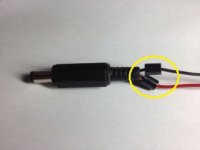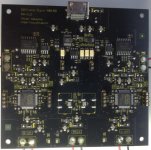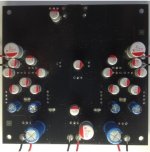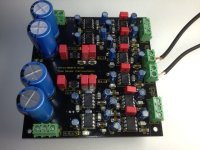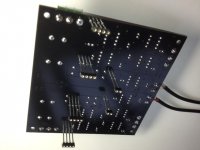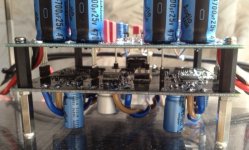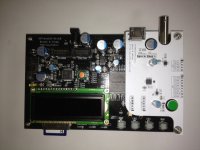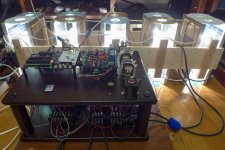The PPS capacitors are SunRing Copper Foil PPS film type 0.022 uF shown on the post #299, #300, #304 for SDTrans384 Rev. 3.0 board.
Hi Bunpei,
are the SunRing Copper foil capacitors still for sale anywhere?
Hi, Raymond!
If you find capacitance values you need on this page and you think their prices are reasonable enough,
ƒTƒ“ƒŠƒ“ƒO�@PPSD
please let me know by a usual internet e-mail. I will buy and send them to you.
Bunpei
If you find capacitance values you need on this page and you think their prices are reasonable enough,
ƒTƒ“ƒŠƒ“ƒO�@PPSD
please let me know by a usual internet e-mail. I will buy and send them to you.
Bunpei
Hi, Raymond!
If you find capacitance values you need on this page and you think their prices are reasonable enough,
ƒTƒ“ƒŠƒ“ƒO�@PPSD
please let me know by a usual internet e-mail. I will buy and send them to you.
Bunpei
Thank you for the info.
The CQ09R2E 0.01uF (due to physical size) are the one I need.
Quantity vs. prices must be checked as I need them in hundreds or thousands..
Do you have contact info for SunRing directly ?
If you purchase their product as an audio device manufacturing company, you can contact to TOSHIN KOGYO Co., LTD. in Nagano, Japan directly through their web page.
Contact-TOSHIN KOGYO
(You must clearly specify the "Sun-Ring" brand name and the capacitance in your inquiry.)
Contact-TOSHIN KOGYO
(You must clearly specify the "Sun-Ring" brand name and the capacitance in your inquiry.)
A surge absorber bead core is effective for a SQ improvement!
Some of you may not believe this claim.
However, I'd like to recommend SDTrans users apply such tiny bead cores on a DC +5V power supply line of SDTrans.
The product is originally a "surge absorber" that removes "spikes" in a line. A Japanese friend of mine told me that it was also very effective for improving a total SQ of SDTrans. First, I thought it must be exaggerated somehow. After trying it with my SDTrans actually, I realized its effectiveness.
In the yellow circles marked on the pictures, you find the bead cores.
You can read an explanation of the product here;
Surge Absorbers : Amorophous Products : Hitachi Metals America
The key of the bead core is "nanocrystalline material".
Domestic list price of the bead core "Black Pearl" is 600 JPY (= 6 USD) /each. I think it is worth trying really.
If you are interested in the product, please contact to Mr. Teramoto of the following e-mail address;
iphone0123 < at > goo < dot > jp
Some of you may not believe this claim.
However, I'd like to recommend SDTrans users apply such tiny bead cores on a DC +5V power supply line of SDTrans.
The product is originally a "surge absorber" that removes "spikes" in a line. A Japanese friend of mine told me that it was also very effective for improving a total SQ of SDTrans. First, I thought it must be exaggerated somehow. After trying it with my SDTrans actually, I realized its effectiveness.
In the yellow circles marked on the pictures, you find the bead cores.
You can read an explanation of the product here;
Surge Absorbers : Amorophous Products : Hitachi Metals America
An externally hosted image should be here but it was not working when we last tested it.
The key of the bead core is "nanocrystalline material".
Domestic list price of the bead core "Black Pearl" is 600 JPY (= 6 USD) /each. I think it is worth trying really.
If you are interested in the product, please contact to Mr. Teramoto of the following e-mail address;
iphone0123 < at > goo < dot > jp
Attachments
If you purchase their product as an audio device manufacturing company, you can contact to TOSHIN KOGYO Co., LTD. in Nagano, Japan directly through their web page.
Contact-TOSHIN KOGYO
(You must clearly specify the "Sun-Ring" brand name and the capacitance in your inquiry.)
Hi Bunpei,
Are there any reason why it is the PPSD series that have been used for audio in Japan and not the PPSC or PPSO series?
PPSC,PPSD,PPSO Series
High-end type film capacitor for audio equipment
●Electrode consists of Copper foils and dielectristics of polyphenylene sulfid films.
電極は銅箔、誘電体はポリフェニレンサルファイドフィルムで構成されています。
●Excelent temperatur characteristics with flat capacitance change.
静電容量の温度特性が極めて優れています。
●性能/Performance
・Category temperature range: -25℃~+85℃
・Rated voltage : 250VDC
・Dissipation factor : 0.005max
PPSC Series
■Capacitance / tolerance
■用途例/The example of Use
Coupling circuit with electrolytic capacitor
電解コンデンサ一緒にとカップリング回路に使用
PPSD Series
■Capacitance / tolerance
■用途例/The example of Use
Equalizer circuit and Feedback circuit.
イコライザー回路、フィードバック回路に使用
PPSO Series
■Capacitance / tolerance
■用途例/The example of Use
Amplifier circuit of very low noise.
極低雑音増幅回路に使用
Manufacturing of the PPS Cu-foil type capacitors was recently passed over from Sun-Ring Company, a very small company, to Toshin. When Sun-Ring manufactured the caps, they used to sell only the PPSD type in a market. That's the simple reason why audiophiles in Japan only used the PPSD type.
I'm not sure whether other types PPSC and PPSO are suitable for audio use or not. Why don't you request a small quantity of samples and evaluate them by yourself?
I'm not sure whether other types PPSC and PPSO are suitable for audio use or not. Why don't you request a small quantity of samples and evaluate them by yourself?
I'm not sure whether other types PPSC and PPSO are suitable for audio use or not. Why don't you request a small quantity of samples and evaluate them by yourself?
OK - will order some and evaluate.
Chiaki's SDTrans-Sync-9018D DAC + I/V system
Product release version of Chiaki's SDTrans-Sync-9018D DAC + I/V system is in the final checking stage at Tachyon shop in Tokyo. Mr. Yamazaki of Tachyon is concentrating on the task.
Attached are pictures of three board.
Next week, Mr. Yamazaki will send his messages to those who has made preliminary reservations.
If you are newly interested in these boards, please send your e-mail to Mr. Yamazaki
jack < at > mtc < dot > biglobe < dot > ne < dot > jp
to ask whether the kit is available or not and prices.
Though he said all the boards in the first batch are already fully assigned to preliminary reservations, there may be some cancels.
The 1st Picture: 9018D DAC board (ES9018 Dualo Mono DAC with 40s MHz NDK oscillators), Top View
The 2nd Picture: 9018D DAC board, Bottom View
The 3rd Picture: I/V (AD797 op-amps) board, Top View
The 4th Picture: I/V board, Bottom View (Joints to the DAC board are shown)
The 5th Picture: The I/V board is stacked on the DAC board
The 6th Picture: Sync-option sub board for SDTrans (The white part)
Product release version of Chiaki's SDTrans-Sync-9018D DAC + I/V system is in the final checking stage at Tachyon shop in Tokyo. Mr. Yamazaki of Tachyon is concentrating on the task.
Attached are pictures of three board.
Next week, Mr. Yamazaki will send his messages to those who has made preliminary reservations.
If you are newly interested in these boards, please send your e-mail to Mr. Yamazaki
jack < at > mtc < dot > biglobe < dot > ne < dot > jp
to ask whether the kit is available or not and prices.
Though he said all the boards in the first batch are already fully assigned to preliminary reservations, there may be some cancels.
The 1st Picture: 9018D DAC board (ES9018 Dualo Mono DAC with 40s MHz NDK oscillators), Top View
The 2nd Picture: 9018D DAC board, Bottom View
The 3rd Picture: I/V (AD797 op-amps) board, Top View
The 4th Picture: I/V board, Bottom View (Joints to the DAC board are shown)
The 5th Picture: The I/V board is stacked on the DAC board
The 6th Picture: Sync-option sub board for SDTrans (The white part)
Attachments
Thx for the photos! Looks real good 
I can´t wait to get my hands on the dual-ESS9018-mono-mode-DAC and the IV-converter. Lots of power supplies will be needed, so I am working on that now.
Of course I also bought some solar panels that I will light up with powerful LED modules
that I will light up with powerful LED modules 
/S
I can´t wait to get my hands on the dual-ESS9018-mono-mode-DAC and the IV-converter. Lots of power supplies will be needed, so I am working on that now.
Of course I also bought some solar panels
/S
Product release version of Chiaki's SDTrans-Sync-9018D DAC + I/V system is in the final checking stage at Tachyon shop in Tokyo. Mr. Yamazaki of Tachyon is concentrating on the task.
Attached are pictures of three board.
Next week, Mr. Yamazaki will send his messages to those who has made preliminary reservations.
If you are newly interested in these boards, please send your e-mail to Mr. Yamazaki
jack < at > mtc < dot > biglobe < dot > ne < dot > jp
to ask whether the kit is available or not and prices.
Though he said all the boards in the first batch are already fully assigned to preliminary reservations, there may be some cancels.
The 1st Picture: 9018D DAC board (ES9018 Dualo Mono DAC with 40s MHz NDK oscillators), Top View
The 2nd Picture: 9018D DAC board, Bottom View
The 3rd Picture: I/V (AD797 op-amps) board, Top View
The 4th Picture: I/V board, Bottom View (Joints to the DAC board are shown)
The 5th Picture: The I/V board is stacked on the DAC board
The 6th Picture: Sync-option sub board for SDTrans (The white part)
Last edited:
More photos taken by Mr. Yamazaki
Hi, staccatiss!
Thank you very much for your post.
Mr. Yamazaki of Tachyon told me links of his photo of Chiaki's kit.
SDTrans and Chiaki's DAC + I/V system

SDTrans with a white Sync-option sub board

SDTrans is playing a DXD source on the system

SDTrans is playing a DSD256 source on the system

I/V board stacked on DAC board

DAC board
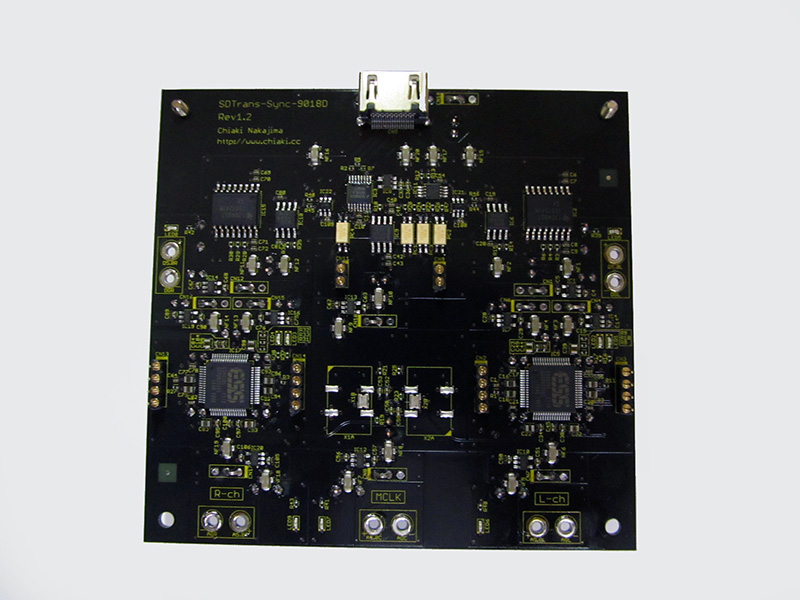
The DAC board has 5 independent +5V DC power input terminals for
Digital L, Digital R, Analog L, Analog R and Clock (Common).
The I/V board has 2 independent +15V, -15V DC power input terminals for
I/V L, I/V R.
Therefore, you can connect utmost 10 DC power lines (including SDTrans) separately to the system.
Hi, staccatiss!
Thank you very much for your post.
Mr. Yamazaki of Tachyon told me links of his photo of Chiaki's kit.
SDTrans and Chiaki's DAC + I/V system

SDTrans with a white Sync-option sub board

SDTrans is playing a DXD source on the system

SDTrans is playing a DSD256 source on the system

I/V board stacked on DAC board

DAC board

The DAC board has 5 independent +5V DC power input terminals for
Digital L, Digital R, Analog L, Analog R and Clock (Common).
The I/V board has 2 independent +15V, -15V DC power input terminals for
I/V L, I/V R.
Therefore, you can connect utmost 10 DC power lines (including SDTrans) separately to the system.
Sync Option SDTrans, DAC & I/V, and complete 10 x Solar Cell power supply
Currently I have the pleasure to borrow the very latest complete sync option SDTrans, DAC & I/V converter (by Chiaki) and a 10-panel Solar Cell power supply built by Bunpei. Each power supply point (10 in all) of the SDTrans, DAC, and I/V converter have its own separate Solar Cell Panel power supply.
Even though there are elements and parts of this system that is still being worked on, I am lucky to have this opportunity to review a complete original system of player, DAC, I/V, and of course the Solar Cell Panel power supply.
Last time I had a listen to the Solar Cell Panel power supply, it was only a single unit Solar Cell Panel power supply unit with two panels feeding my Fidelix Caprice DAC and SDTrans with 90/98 MHz clocks.
This time I have the complete system with the new DAC and I/V and individual Solar Cell Panel power supplies for each separate section that needs to be supplied with power.
I have gone through the same music collection I normally use for testing, and also thrown in whatever music I have felt like listening to spontaneously. I do play source material from 2L / Lindberg Lyd (Norway) in DSD and 352.8/24bit DXD, as well as various music downloaded from HDTracks at various formats like 48/24, 88.2/24, 96/24. 176.4/24, and 192/24. But ultimately I play the music I like in whatever format it happen to be in, which in the end means that a lot will be in "plain vanilla" 44.1/16 as ripped from my own CD collection.
The resolution and definition of everything I throw at the current digital source playback system (including the "plain vanilla stuff") is SKY-HIGH and VERY ENJOYABLE. I can simply say that to me this is the ultimate digital source playback system known to me as of today. Even though a complete system like I have here now will be an investment of "real money", perhaps beyond what some "do it yourself enthusiast" is willing to spend, I can tell you that the asking price (from Tachyion) is "dirt cheap" as compared to all commercially available high-end audio offerings available on the market. And my guess is that there is no system more aurally pleasing.
The downside is in the user interface and the limitation to playing WAV files prepared on your computer only. It is hard to watch the text on the tiny display to figure out what to play next, and in general to "find" your music spread out over several SD cards. However, THE REWARD in sonic pleasure (to me at least) is such that I never complain, and I have virtually stopped listening to other digital source components that I also have available (some quite costly CD players and DACs, and also some quite reasonably good USB solutions that I also think have improved a lot during recent years.)
I have no financial involvement with Tachyon, and I am also in the process of purchasing several SDTrans, DAC etc. from them (as an ordinary customer). Obviously I am friends with Bunpei & Chiaki, but I am judging the sonic results solely on their own merits, and I would not hesitate to go elsewhere if that gave me better results. So far "THIS IS IT" for me
Currently I have the pleasure to borrow the very latest complete sync option SDTrans, DAC & I/V converter (by Chiaki) and a 10-panel Solar Cell power supply built by Bunpei. Each power supply point (10 in all) of the SDTrans, DAC, and I/V converter have its own separate Solar Cell Panel power supply.
Even though there are elements and parts of this system that is still being worked on, I am lucky to have this opportunity to review a complete original system of player, DAC, I/V, and of course the Solar Cell Panel power supply.
Last time I had a listen to the Solar Cell Panel power supply, it was only a single unit Solar Cell Panel power supply unit with two panels feeding my Fidelix Caprice DAC and SDTrans with 90/98 MHz clocks.
This time I have the complete system with the new DAC and I/V and individual Solar Cell Panel power supplies for each separate section that needs to be supplied with power.
I have gone through the same music collection I normally use for testing, and also thrown in whatever music I have felt like listening to spontaneously. I do play source material from 2L / Lindberg Lyd (Norway) in DSD and 352.8/24bit DXD, as well as various music downloaded from HDTracks at various formats like 48/24, 88.2/24, 96/24. 176.4/24, and 192/24. But ultimately I play the music I like in whatever format it happen to be in, which in the end means that a lot will be in "plain vanilla" 44.1/16 as ripped from my own CD collection.
The resolution and definition of everything I throw at the current digital source playback system (including the "plain vanilla stuff") is SKY-HIGH and VERY ENJOYABLE. I can simply say that to me this is the ultimate digital source playback system known to me as of today. Even though a complete system like I have here now will be an investment of "real money", perhaps beyond what some "do it yourself enthusiast" is willing to spend, I can tell you that the asking price (from Tachyion) is "dirt cheap" as compared to all commercially available high-end audio offerings available on the market. And my guess is that there is no system more aurally pleasing.
The downside is in the user interface and the limitation to playing WAV files prepared on your computer only. It is hard to watch the text on the tiny display to figure out what to play next, and in general to "find" your music spread out over several SD cards. However, THE REWARD in sonic pleasure (to me at least) is such that I never complain, and I have virtually stopped listening to other digital source components that I also have available (some quite costly CD players and DACs, and also some quite reasonably good USB solutions that I also think have improved a lot during recent years.)
I have no financial involvement with Tachyon, and I am also in the process of purchasing several SDTrans, DAC etc. from them (as an ordinary customer). Obviously I am friends with Bunpei & Chiaki, but I am judging the sonic results solely on their own merits, and I would not hesitate to go elsewhere if that gave me better results. So far "THIS IS IT" for me
Attachments
Oh, wow! What sonical pleasure it must give you and also what joy for Chiaki and Bunpei who have been working hard on the system for many years!
Some comments if I may. I use the remote control kit from T. and I find that the user interface now is much better compared to the buttons on the player PCB. Before I had the remote control kit, I said to myself that this is no worse than playing LP:s! And I called playback SDtrans hard core style ;-)
We can also play DSD files and DXD files and not only WAV files
I have been thinking about the display being normally small. Some form of lens that enlarges the display must surely be had some where. I have looked around a bit but did not find it.
/S
Some comments if I may. I use the remote control kit from T. and I find that the user interface now is much better compared to the buttons on the player PCB. Before I had the remote control kit, I said to myself that this is no worse than playing LP:s! And I called playback SDtrans hard core style ;-)
We can also play DSD files and DXD files and not only WAV files
I have been thinking about the display being normally small. Some form of lens that enlarges the display must surely be had some where. I have looked around a bit but did not find it.
/S
Currently I have the pleasure to borrow the very latest complete sync option SDTrans, DAC & I/V converter (by Chiaki) and a 10-panel Solar Cell power supply built by Bunpei. Each power supply point (10 in all) of the SDTrans, DAC, and I/V converter have its own separate Solar Cell Panel power supply.
Even though there are elements and parts of this system that is still being worked on, I am lucky to have this opportunity to review a complete original system of player, DAC, I/V, and of course the Solar Cell Panel power supply.
Last time I had a listen to the Solar Cell Panel power supply, it was only a single unit Solar Cell Panel power supply unit with two panels feeding my Fidelix Caprice DAC and SDTrans with 90/98 MHz clocks.
This time I have the complete system with the new DAC and I/V and individual Solar Cell Panel power supplies for each separate section that needs to be supplied with power.
I have gone through the same music collection I normally use for testing, and also thrown in whatever music I have felt like listening to spontaneously. I do play source material from 2L / Lindberg Lyd (Norway) in DSD and 352.8/24bit DXD, as well as various music downloaded from HDTracks at various formats like 48/24, 88.2/24, 96/24. 176.4/24, and 192/24. But ultimately I play the music I like in whatever format it happen to be in, which in the end means that a lot will be in "plain vanilla" 44.1/16 as ripped from my own CD collection.
The resolution and definition of everything I throw at the current digital source playback system (including the "plain vanilla stuff") is SKY-HIGH and VERY ENJOYABLE. I can simply say that to me this is the ultimate digital source playback system known to me as of today. Even though a complete system like I have here now will be an investment of "real money", perhaps beyond what some "do it yourself enthusiast" is willing to spend, I can tell you that the asking price (from Tachyion) is "dirt cheap" as compared to all commercially available high-end audio offerings available on the market. And my guess is that there is no system more aurally pleasing.
The downside is in the user interface and the limitation to playing WAV files prepared on your computer only. It is hard to watch the text on the tiny display to figure out what to play next, and in general to "find" your music spread out over several SD cards. However, THE REWARD in sonic pleasure (to me at least) is such that I never complain, and I have virtually stopped listening to other digital source components that I also have available (some quite costly CD players and DACs, and also some quite reasonably good USB solutions that I also think have improved a lot during recent years.)
I have no financial involvement with Tachyon, and I am also in the process of purchasing several SDTrans, DAC etc. from them (as an ordinary customer). Obviously I am friends with Bunpei & Chiaki, but I am judging the sonic results solely on their own merits, and I would not hesitate to go elsewhere if that gave me better results. So far "THIS IS IT" for me
Looks fantastic!
/S
/S
Mr. Yamazaki of Tachyon in Tokyo shows a picture of
SDTrans384+Sync-SDT+Sync-9018D DAC+9018D-I/V system
integrated by one of SDTrans users in Japan.
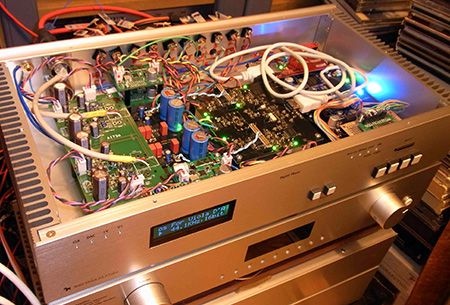
I heard that the user was satisfied with its performance very much.
Hello Bunpei, i would back to 2010year for a while. i'm very impressed about mr. Ishida works. i'm interested about using FE5680a rubidium master clock with counters and multipliers. ii'm looking for this type of solution. i need output freq=45.0000MHz and as i see it is possible but i don't know how it made. can you contact with mr. Ishida and ask him in my behalf? I will be very grateful. and please clear your inbox because it is impossible to send you private message
Hi, vertigen!
I have forwarded your request to Mr. Ishida. However,
I can't guarantee his direct reply to you.
I'm afraid his original multiplier was limited to 2x and resultant frequency was < 40 MHz as far as I remember.
In addition, he found a better Rb-tube calibrated VCXO unit that employs better DDS device and abandoned the FE5680 unit he used before.
Bunpei
I have forwarded your request to Mr. Ishida. However,
I can't guarantee his direct reply to you.
I'm afraid his original multiplier was limited to 2x and resultant frequency was < 40 MHz as far as I remember.
In addition, he found a better Rb-tube calibrated VCXO unit that employs better DDS device and abandoned the FE5680 unit he used before.
Bunpei
Last edited:
- Home
- Source & Line
- Digital Source
- MicroSD Memory Card Transport Project
